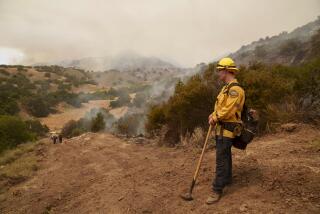Worst Colorado wildfire in history burns 55,000 acres, 181 homes
- Share via
Firefighters in Colorado braced for high winds that threatened to blow the state’s most destructive fire in recorded history from treetop to treetop on Sunday.
At least 181 homes have been destroyed by the 55,050-acre High Park fire roughly 15 miles west of Fort Collins. Lightning sparked the blaze on June 9, officials say.
“There are a still a lot of folks who don’t know whether they have homes or not,” Kristy Wumkes, a spokesperson for the firefighting effort, told the Los Angeles Times. “They’re our friends, our neighbors. All of us know people who have lost homes.”
Roughly 1,800 evacuation notices are still in place, Wumkes said, and the fire was 45% contained as of Sunday morning.
Yet despite predictions of 40-to-50 mph winds on some ridge tops Sunday that could push the fire over more of the area’s sloping, densely forested terrain, the blaze only grew 1,000 acres over Saturday night, Wumkes said.
The fire is growing westward, deeper into the Roosevelt National Forest and farther from homeowners’ properties to the east. Wumkes said 1,199 evacuation notices have been lifted and none of the more than 1,600 firefighters have been reported hurt. At least one homeowner died last week.
A Denver man was arrested Sunday morning on suspicion of impersonating a firefighter. Police said Michael Maher, 30, was driving in a fire zone in a silver Toyota Tacoma, “phony firefighter credentials” and a stolen government license plate. When the truck was found at a bar later, it had a gun and stolen property inside, police said.
The fire’s busy western front presents a challenge for firefighters, who often have to deal with ridge after ridge of dense forest and sudden creek bottoms along with low humidity and a daytime temperature in the 90s.
“A lot of steep gullies, cliffs — the slopes are quite vertical,” Wumkes said. “It’s like a double-black-diamond ski slope or steeper.”
The densely forested area also provides a lot of fuel for the fire. Officials have brought in equipment to essentially do on-the-spot logging to remove trees that are in the blaze’s path and to create space for firefighters to work and make a stand, Wumkes said.
“This is an area that’s had a lot of time to build up those fuels,” Wumkes said. “A lot of the trees in this forest are about 150 years old,” which is the last time a large fire cleared out the area.
Accompanying the blaze has been some political squalling over the capabilities of the nation’s aging air-tanker fleet, often a fixture in tough-to-get-to wildfires such as these.
The U.S. Forest Service’s newest heavy air tanker is 51 years old, according to the Denver Post, and only nine tankers remain in a fleet that numbered 44 a decade ago as the forest service also catches fewer fires in their early stages.
A forest service spokeswoman said it had enough air resources, but Jim Hall — a former National Transportation Safety Board chairman who headed a 2002 commission that recommended the forest service bolster its fleet — had serious concerns.
“It’s been 10 years, and precious little has been done,” Hall told the Denver Post. “We are going to see one of the major cities in the West go up in fire because of this inaction.”
More to Read
Sign up for Essential California
The most important California stories and recommendations in your inbox every morning.
You may occasionally receive promotional content from the Los Angeles Times.














